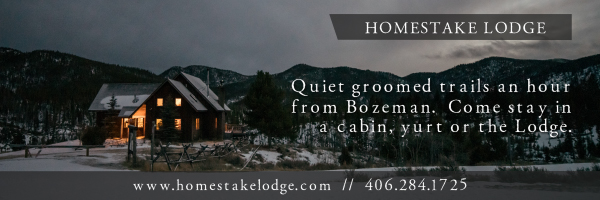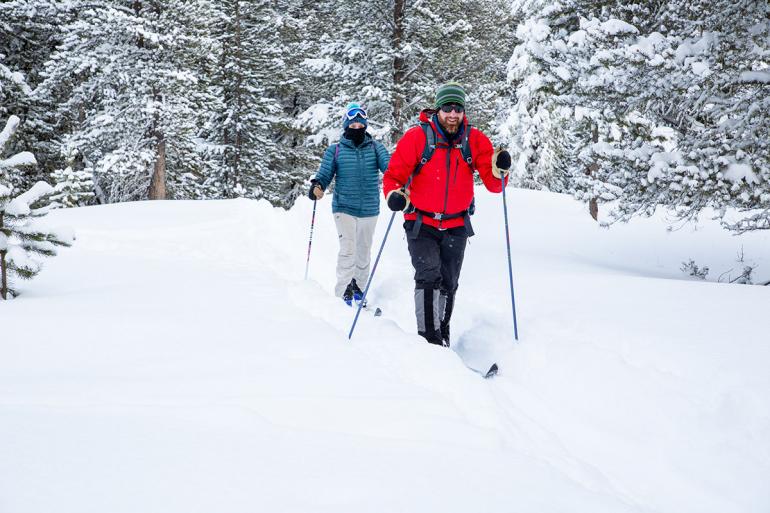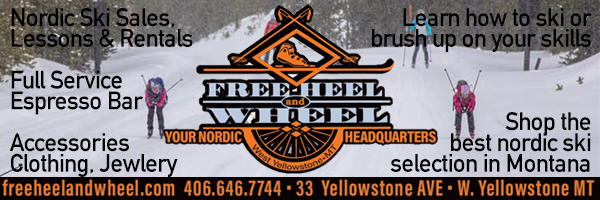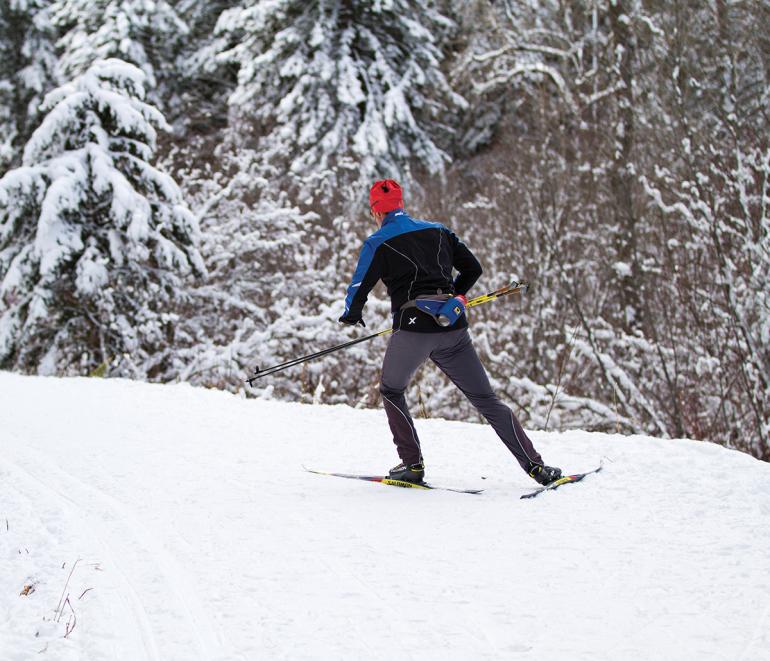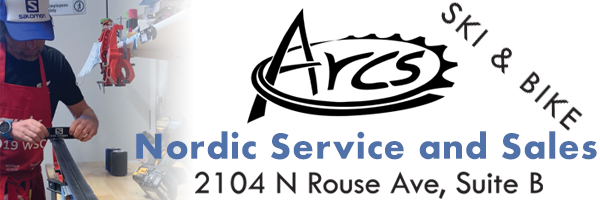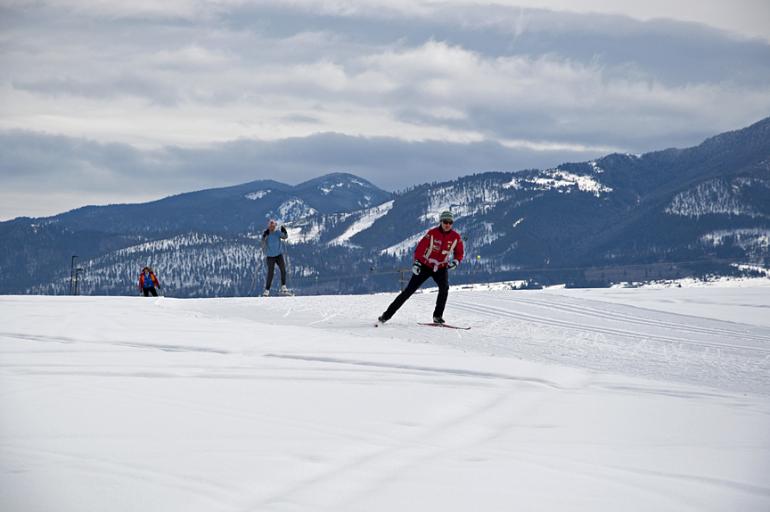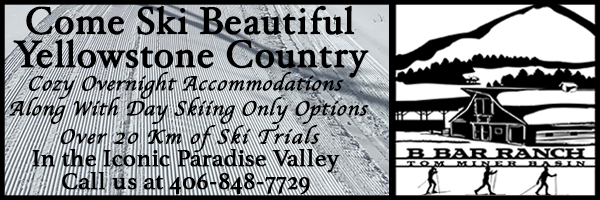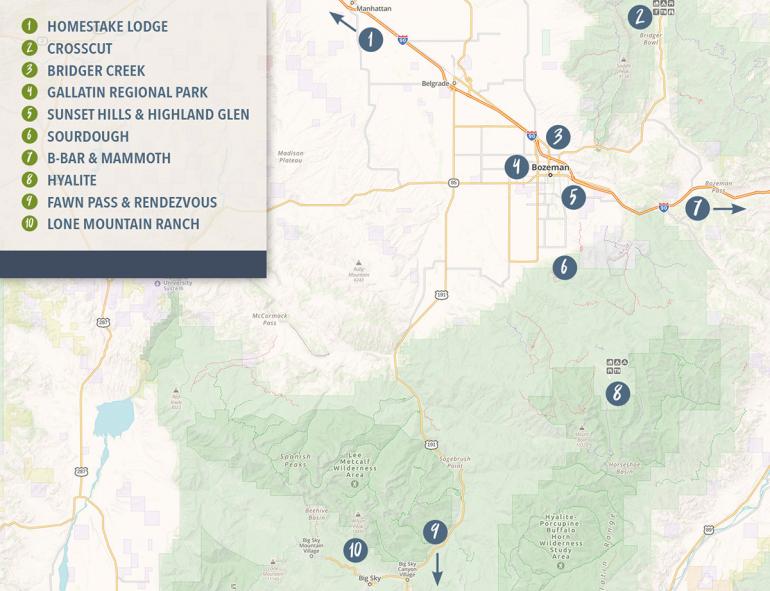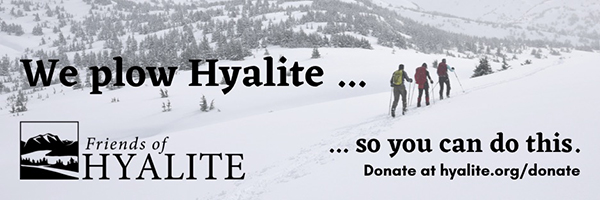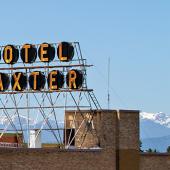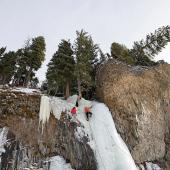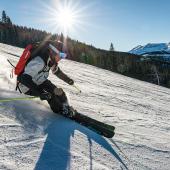Skinny Skis
Bozeman's Nordic opportunities.
No one cares if you call it cross-country or Nordic skiing, but in these parts, once the snow flies, skinny skis become as commonplace as running shoes. Bozeman’s Nordic scene has a national reputation, and while you’ll likely see both former and aspiring Olympians and Paralympians on the trails, our tracks are filled with people of all ages and abilities. The motto here is to “keep the people skiing.”
In-town trails make it easy to sneak a ski into a busy day, even in the dark, and a short drive will bring you to dozens of mountainous experiences.
For newbies: rejoice that cross-country skiing has a relatively low cost to entry, made even better by free access on many of the local trails and the nonprofit status held by all of Bozeman’s ski organizations. Plus, it is a relatively easy learning curve, even if you’ve never been on skis. The best part: you can shuffle down the trail at an easy walking pace or you can speed it up for a full-body cardio workout.
Where to Go
The Bridger Ski Foundation (BSF) grooms more than 70 km of community Nordic trails in and around Bozeman that are free and open to the public (but the Bozeman way is to buy a voluntary trail pass from BSF in order to keep their donor-funded groomers running).
In town, BSF has a new snowmaking system on nearly 5 km at Sunset Hills, next to the hospital. Cross the road for nearly 10 km of rolling terrain at Highland Glen.
Beginners often seek out the flatter trails of the Bridger Creek Golf Course, Gallatin Regional Park, or a 1 km loop on the MSU campus.
Just outside of town, Sourdough Canyon is a mecca for skiers, dog walkers, and runners. While the lower miles are often a circus requiring excellent patience, those with endurance can find solitude and miles of groomed trail going all the way to Mystic Lake (20 miles round-trip) and the Moser pass. Hyalite boasts a massive network of both groomed and ungroomed trails, with the loops at the Blackmore trailhead being a favorite place to begin.
Up Bridger Canyon, a day (or season) pass grants you access to Crosscut Mountain Sports Center’s stunning 50 km of cross-country trails, including wide groomers and narrow-gauge trails. You can also explore dozens of ungroomed trails and Forest Service roads around Bozeman.
For those willing to drive longer, the options unfold. Go west on I-90 for trails at Homestake Lodge where you can find more than 35 groomed trails offering majestic views of the Tobacco Roots. Or, head south toward Big Sky for a day at Lone Mountain Ranch’s extensive network. Keep going to West Yellowstone to experience the Rendezvous Ski Trails, which attract skiers from across the country starting in November for early-season skiing. If you're in the area, make sure to stop in at FreeHeel and Wheel, a top-notch ski shop that can service all of your Nordic needs and more.
If you’ve made it that far, we should mention that the Nordic skiing in Yellowstone National Park is spectacular. You can also enter the Park from the north via Gardiner and ski a groomed loop around the Mammoth Hot Springs terraces for some otherworldly scenery. Also in the area is the esteemed B Bar Ranch. Here, discover an intimate adventure—ski for the day and bed down for the night.
Come spring, there’s a little-known phenomenon called “crust cruising,” in which skate skiers set off across the cold-hardened, sun-crusted snowscape and cruise without a trail, often into remote areas. (The trick, of course, is to go early, so as not to get caught four miles from your car when the snow gets soft and you start to sink in.) Fawn Pass is a popular crust-cruising destination.
You’ll find many types of ski trails around here—some for skiers only, some that allow dogs, and some that allow multiple kinds of trail users. In Yellowstone Park, that may mean you’ll share the trail with a few post-holing bison. Know what kind of trail you’re on and the rules (and safety measures) for that location.
Learning
Good technique makes Nordic skiing infinitely easier and a whole lot more fun. You can find instruction (from a few hours to winter-long sessions) with several local groups: MSU Outdoor Recreation, Bridger Ski Foundation (BSF), Crosscut Mountain Sports Center, Montana Endurance Academy, Big Sky Ski Education Foundation, and Lone Mountain Ranch. If you want to combine shooting guns and skiing (a.k.a., biathlon), check out Crosscut’s biathlon programs.
Essential Gear
The most complicated thing about Nordic skiing is the equipment lingo. Sure, you only need boots, poles, and skis, but there are binding-compatibility issues, different ski types, and some confusing terms along the way. Lean on our local ski-shop staff to help you.
There are two types of Nordic skiing techniques; each involves a slightly different boot and ski. Most beginners start with classic skiing, which is a walking or running motion. Your skis either have scales or a grippy wax on the bottom giving you the ability to “kick” yourself forward. (This is your best option if you want to keep it mellow or explore ungroomed trails.) Some classic skis are designed mainly for groomed trails while other classic skis are wider, sometimes with metal edges, and best for ungroomed trails. Then there’s skate skiing, which uses the same motion as hockey skating. It’s faster, a bit addicting once you learn, and a great way to discover your max heart rate. You need groomed trails (or crust) to skate.
MSU Outdoor Recreation lends and rents skis to students. Arcs Ski and Bike is a great place to stop in town for gear and tunes. They specialize in high-end, race-ready equipment but can provide something for everyone looking to get out on the trail. The general public can rent or buy at Bangtail Ski & Bike, Chalet Sports, and Roundhouse Sports. Both Crosscut and Lone Mountain Ranch offer rentals at their ski centers. Used gear is also a great option. Shop the BSF Ski Swap on the first weekend of November for thousands of items, as well as Play It Again Sports and Second Wind.
For clothing, dress in layers. While the clothing you might wear on a winter run is mostly appropriate, temps drop quickly and windproof layers are your savior (especially on the downhills). If you’re headed out for a longer or more remote route, add proper safety equipment: food, water, warmer layers, a navigation device, and other backcountry essentials.
Etiquette
When using groomed trails, treat those corduroy surfaces as sacred snow that needs to be preserved: Keep footprints out of the trail (unless the trail allows foot traffic) and don’t track in mud. Around here, we use the Ski Kind principles (detailed below). It doesn’t matter who is speeding along, shuffling, or just learning to stay upright, sharing the trail is key.
Ski No Trace
Leave only tracks. Don’t leave poop (yours or your pup’s) or trash near the trail.
Ski Gracious
Share the trail with all speeds and abilities. Yield, slow down, and give a friendly hello to make everyone feel welcome.
Ski Aware
Know what type of trail you’re skiing and the rules for that location. Be aware of terrain, grooming equipment, and other trail users.
Ski Kind
Bring your best self to the trail and spread the joy of skiing. Share your knowledge and help others.
Ski Supportive
Give back to the trails you ski. Volunteer. Donate to local trail organizations, clubs, and groomers. The trails don't groom themselves, someone has to do the work to make sure the roads are plowed and things are ready for the season. If you're looking to give back, Friends of Hyalite is a great place to start.
Ski Safe
Technically, downhill skiers have the right of way, but they still need to think of other trail users as yield signs and slow down. Before you pass others, slow down and announce yourself. Give space. Use extra caution on blind corners and downhills.
Literature
The Last Best Ski MT offers a beautifully illustrated and informative look into the nearby skiing options. The book is only half the fun as videos and interviews can be found at the many QR codes throughout the book.
Events
You needn’t be an advanced skier or a speed demon to jump into the local scene around here. Here are a few of our favorite events.
Ongoing
Biathlon Races – Crosscut. Our backyard Nordic center hosts a series of fun community biathlon races throughout the winter. crosscutmt.org.
FUNSKI Community Series – Various locations. BSF hosts one race per month during the winter, usually on weeknights. Themes range from a Santa chase to a lively two-person relay. Costumes encouraged. bridgerskifoundation.org.
Clinics – Bozeman. BSF offers Nordic ski clinics throughout the winter, providing an easy way to drop in and learn a few ski tips. bridgerskifoundation.org.
January
Hyalite Tour – Hyalite. This isn’t a race, just a great day to go ski the trails in Hyalite with friends and finish with free food & hot cocoa. Pick your distance and trail. hyalite.org.
Snoflinga – Butte. This festive three-day event hosts free skiing and and snowshoe lessons along with a plethora of other activities. Sign up here.
Women's Skate Clinic – Homestake Lodge. Incredible coaches and a fun atmosphere. Need we say more? homestakelodge.com/events.
February
Montana Cup Race, Homestake Hustle – Homestake Lodge. homestakelodge.com/events.
March
Yellowstone Rendezvous – West Yellowstone. A good portion of Bozeman heads to West Yellowstone each March for the final races of the season with a 2k, 5k, 10k, 25k, and 50k. skirunbikemt.com.



